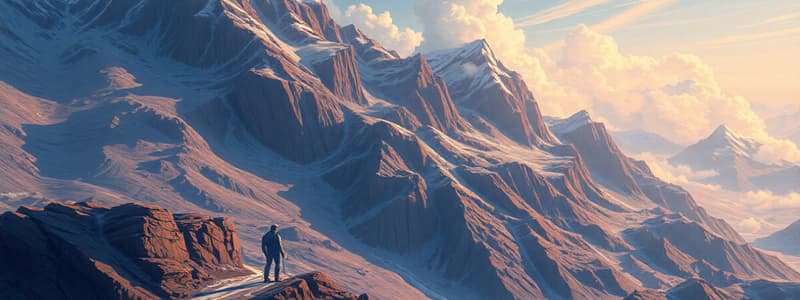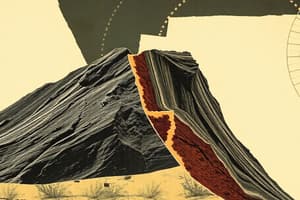Podcast
Questions and Answers
What is the primary characteristic of creep in mass movements?
What is the primary characteristic of creep in mass movements?
- Triggered only by earthquakes
- Liquid-like flow of mud
- Very slow downward movement of soil (correct)
- Fast descent of rock and debris
How do mudflows differ from earth flows?
How do mudflows differ from earth flows?
- Earth flows are always triggered by earthquakes
- Earth flows are completely dry materials
- Mudflows occur only in volcanic regions
- Mudflows are faster and consist of mud and water (correct)
What distinguishes a lahar from other types of mudflows?
What distinguishes a lahar from other types of mudflows?
- They occur in volcanic areas with melting snow (correct)
- They are the slowest type of mudflow
- They are only found in arid regions
- They are always triggered by landslides
Which scenario best describes a landslide?
Which scenario best describes a landslide?
What factor significantly contributes to the occurrence of landslides?
What factor significantly contributes to the occurrence of landslides?
In a rockslide, what typically triggers the movement?
In a rockslide, what typically triggers the movement?
Which mass movement is characterized by very slow movement of soil due to freeze-thaw cycles?
Which mass movement is characterized by very slow movement of soil due to freeze-thaw cycles?
Which of the following is NOT a factor in triggering mudflows?
Which of the following is NOT a factor in triggering mudflows?
What commonly contributes to rockfalls occurring on high cliffs?
What commonly contributes to rockfalls occurring on high cliffs?
Which factor most significantly increases the risk of mass movements in built environments?
Which factor most significantly increases the risk of mass movements in built environments?
What is the most effective way to mitigate risks associated with mass movements?
What is the most effective way to mitigate risks associated with mass movements?
Where do rockfalls most commonly occur?
Where do rockfalls most commonly occur?
Which of the following is a consequence of mass movements for people?
Which of the following is a consequence of mass movements for people?
What is mass movement primarily caused by?
What is mass movement primarily caused by?
Which of the following is not a factor affecting slope stability?
Which of the following is not a factor affecting slope stability?
Which trigger is most likely to cause rapid mass wasting?
Which trigger is most likely to cause rapid mass wasting?
What is the definition of creep in terms of mass movement?
What is the definition of creep in terms of mass movement?
How can one identify that creep has occurred?
How can one identify that creep has occurred?
Which of the following activities can lead to the oversteepening of slopes?
Which of the following activities can lead to the oversteepening of slopes?
What role does vegetation play in slope stability?
What role does vegetation play in slope stability?
Which type of mass movement is characterized by a sudden and rapid descent of materials down a slope?
Which type of mass movement is characterized by a sudden and rapid descent of materials down a slope?
What is required for mass movement to occur in terms of surface interactions?
What is required for mass movement to occur in terms of surface interactions?
What characterizes a slump in mass movements?
What characterizes a slump in mass movements?
What type of mass movement is specifically associated with heavy snow and slippery conditions?
What type of mass movement is specifically associated with heavy snow and slippery conditions?
Which of the following factors can trigger mass movements such as slides and slumps?
Which of the following factors can trigger mass movements such as slides and slumps?
Which statement is true about the material movement in a slump?
Which statement is true about the material movement in a slump?
What is a key factor differentiating an avalanche from other types of mass movement?
What is a key factor differentiating an avalanche from other types of mass movement?
What causes rock mass movement in general?
What causes rock mass movement in general?
Which type of slide occurs in areas with substantial snow accumulation?
Which type of slide occurs in areas with substantial snow accumulation?
Flashcards are hidden until you start studying
Study Notes
Mass Movements
- The downslope movement of soil and weathered rock resulting from the force of gravity is called mass movement.
- Almost all of Earth's surface undergoes some degree of mass movement.
Factors Affecting Slope Stability
- Type of earth material
- Slope angle and Topography
- Climate
- Vegetation
- Water
- Time
Triggers for Rapid Mass Wasting
- Rain
- Oversteepening
- Cutting at the foot of slope
- Piling on the head of slope
- Deforesting/ Devegetation
- Earthquakes
Types of Mass Movements
- Creep: The slow, steady, downhill flow of loose, weathered Earth materials, especially soils, is called creep.
- Flows
- Earth flows are moderately slow movements of soils, whereas mudflows are swiftly moving mixtures of mud and water.
- Mudflows can be triggered by earthquakes or vibrations.
- Lahars are mudflows that occur in volcanic regions where the heat from a volcano melts snow on nearby slopes that have fine sediment and little vegetation.
- Slides
- A rapid, downslope movement of Earth materials that occurs when a relatively thin block of soil, rock, and debris separates from the underlying bedrock is called a landslide.
- Landslides are common on steep slopes, especially when soils and weathered bedrock are fully saturated by water.
- A rockslide is a type of landslide that occurs when a sheet of rock moves downhill on a sliding surface.
- Rockslides are often triggered by earthquakes.
- A slump results when the mass of material in a landslide moves along a curved surface.
- Landslides that occur in mountainous areas with thick accumulations of snow are called avalanches.
- Avalanches occur when snow that falls on an icy crust builds up, becomes heavy, slips off, and slides downslope.
- Rockfalls
- On high cliffs, rocks that are loosened by physical weathering processes or by plant growth can break up and fall directly downward.
- Rockfalls commonly occur at high elevations, in steep road cuts, and on rocky shorelines.
Mass Movements Affect People
- Human activities such as construction of buildings, roads, and other structures can make slopes unstable, contributing to the factors that cause mass movements.
- The best way to reduce the number of disasters related to mass movements is to educate people about the problems of building on steep slopes.
Studying That Suits You
Use AI to generate personalized quizzes and flashcards to suit your learning preferences.




